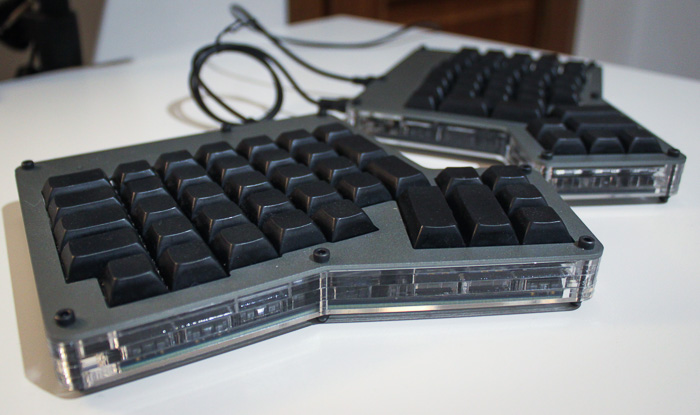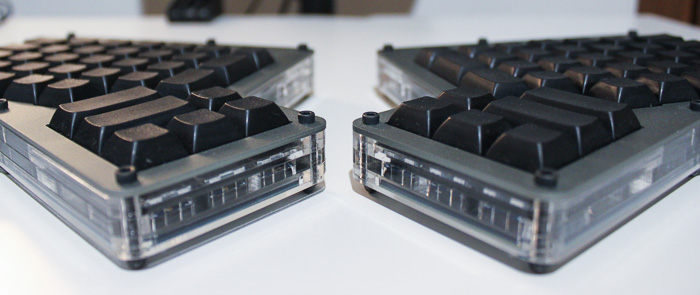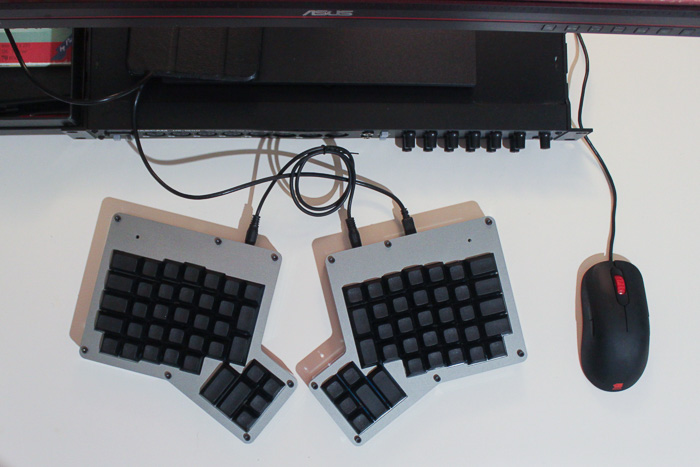
The ErgoDox is a DIY ergonomic keyboard, featuring a split design—each half, one hand. The two halves are connected with a phone TRRS connector cable, while the connection to the PC—or Mac or Unix—is obtained trough a detachable mini USB.
History
The project has been initiated by Dominic Beauchamp—aka Dox, from which the keyboard name derives—on the GeekHack.org forum; the design has been largerly inspired by the Key64 project by Nestor Diaz.
The ErgoDox keyboard is licensed with GNU GPL v3, everybody can make their own modifications, with the only constraint that the original name ErgoDox is protected.

The keyboard
The keyboard itself accomodates approximately 76 keys. The size of keycaps may vary according to function and position. Keycaps can be repositioned according to preference and keys itself—thanks to a Teensy 2.0 AVR Microcontroller—can be remapped to accomplish different layouts—QWERTY, Dvorak, Colemak, etc...—and/or personal preferences.
The typical ErgoDox sports Cherry MX switches. It can, of course, mount any type of commercial Cherry MX. ALP switches are another option. As for keys, the most popular are Signature Plastics PBT DSA keycaps, which are characterized by their rounded shape, a low profile, nice textured surface and no legend—commonly referred to as ninja or stealth.
There are three casings for sale that I personally know about:
- The original case designed by Dox, it is the most refined version but also the less popular due to the 3D printing costs.
- The acrylic case by lilster, is the one you see in the pictures, it is made by sheets of acrylic stacked together, and it is completly trasparent. On mine there's a top aluminum plate, but just for a more minimalistic/rugged look.
- The PVC case by Falbatech, available both in white and black, probably one of the best compromises in terms of better look/price ratio right now.
Feel
The fingers, can spread horizontally and stay relaxed, benefiting from a more open and natural course of movement, each key is within reach. Partly of that is thanks to the fact that keycaps are distributed in columns instead of rows. Thumbs, have their own set of keys, and being the thumbs, the most powerful and usually neglected fingers, this is big deal—normally you would use just one and just for hitting the spacebar. Wrists, won't move much like they would on a normal one—except for a few key combos—resulting in dimished/absent wrist pain over prolonged periods of use.
I would definitely reccomend it to a 9-to-5 computer user, it may take some effort to adapt, but it pays back with interests. Expecially if you're a typist, writing a book or articles, the ErgoDox feels like the fountain pen of keyboards. Software developers and gamers might find it a little bit limitating, because of the missing function keys which many IDE and games take advantage of, and although keys can be remapped, I do see some difficulties with more intricate patterns. It can even backfire as a collaboration deterrent—I advise to keep a normal keyboard always connected to the workstation, as a courtesy to colleagues

How to buy
The ErgoDox can't be purchased from any official store or retailer, it must be built, unless someone is willing to sell his own, which is pretty rare. Luckily, there are few people that offer assembly as a service.
Electronic parts, can be bought trough Massdrop. Massdrop is a company focused on group buys, users can commit to buy a certain item, and if enough committers are reached, the group buy—aka drop—gets submitted to the supplier. Multiple suppliers may be involved, but worry not! Massdrop will take care of all the logistics, charge you one single payment and ship the whole package.
It should be noted that drops, because of their crowdsourced nature, are not always open, instead, they're based on the sum of user requests for the item. Typically—at the time of writing—new drops for ErgoDoxes are opened every few months.
But shipping costs and import taxes from U.S. might spike the deal, a more budget friendly alternative for europeans would be Falbatech, a Polish company started by two brothers, it sells pretty much all the parts plus, optional assembly.
Ergodox assembly

Parts:
- 1x Teensy 2.0 AVR Microcontroller
- 2 Cases (PVC/Layered acrylic/3D) and screws
- 2 PCB
- 76-80 x Cherry MX switch
- 76-80 x 1N4148W-7-F diode (in-hole/smd)
- 1 x MCP23018 I/O expander
- 2 x 3.5mm TRRS connectors
- 1 x TRRS cable
- 1 x USB mini B plug
- 1 x 0.1uF ceramic capacitor
- 1 x 2.2k ohm resistor
- 3 x 3mm T1 LED
- 2 x 220 ohm resistor
- 2 x USB cable Male A to male mini B
First thing to consider is soldering, if you're new to this, I would reccomend to start on YouTube, then you'll need at minimum:
- SMD solder iron—fine tip, scalpel even better
- Solder wire
- Solder wick for cleaning excees of solder or for reworks
The following two resources describe all the process in detail. WhiteFireLion's video in particular, is very comprehensive:
Another great resource is the Massdrop Assembly Instructions page
References